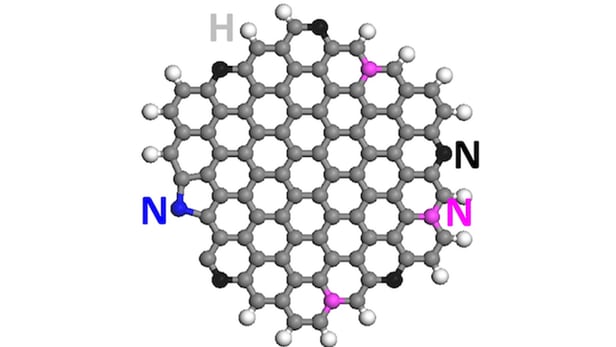Graphene quantum dots can convert CO2 into liquid fuels

Rice University researchers have used nitrogen-doped graphene quantum dots to convert carbon dioxide into liquid hydrocarbons like ethylene and ethanol, for use as fuel(Credit: Ajayan Group/Rice University)
The wonder-material graphene may have a new trick to add to its resume: converting carbon dioxide into liquid fuels. A team at Rice University has used nitrogen-doped graphene quantum dots (NGQDs) as a catalyst in electrochemical reactions that create ethylene and ethanol, and the stability and efficiency of the material is close to that of common electrocatalysts like copper.
Reducing the amount of carbon dioxide that enters the atmosphere is one weapon in the fight to slow climate change, and plenty of research is looking into how we can capture carbon at the source, using clay, engineered bacteria, metal-organic frameworks or materials like the "Memzyme," and sequester it into rock and concrete. Other studies are focusing on how we can convert that captured carbon into liquid hydrocarbons, which can then be used as fuel.
For that purpose, the Rice researchers found that NGQDs are a surprisingly effective electrocatalyst. The materials are made from sheets of graphene a single atom thick, divided into dots only a few nanometers wide. Comprised entirely of carbon, these graphene dots wouldn't be able to convert CO2 by themselves, so the team added nitrogen atoms to the mix, which trigger chemical reactions in response to an electric current, and carbon dioxide.
"Carbon is typically not a catalyst," says Pulickel Ajayan, leader of the study. "One of our questions is why this doping is so effective. When nitrogen is inserted into the hexagonal graphitic lattice, there are multiple positions it can take. Each of these positions, depending on where nitrogen sits, should have different catalytic activity. So it's been a puzzle, and though people have written a lot of papers in the last five to 10 years on doped and defective carbon being catalytic, the puzzle is not really solved."
How it works may remain a mystery for now, but the results are promising regardless. Several materials have been tested as electrocatalysts, with copper rising as one of the main contenders. But in terms of efficiency, the NQGDs were found to perform to about the same level as copper, reducing the amount of carbon dioxide released by up to 90 percent, and converting 45 percent of that captured into small quantities of ethylene and ethanol, to then be used as fuel. The NGQDs were also found to keep this up over a long stretch of time.
"It is surprising because people have tried all different kinds of catalysts," says Ajayan. "And there are only a few real choices such as copper. I think what we found is fundamentally interesting, because it provides an efficient pathway to screen new types of catalysts to convert carbon dioxide to higher-value products."
Lab experiments don't always translate to commercial applications though, and the researchers point out that it could be a while before these NGQDs are put to work in a real-world setting. Current industrial practice is to create fuels using thermal catalysis instead of electrocatalysis, as it scales better.
"For that reason, companies probably won't use it any time soon for large-scale production," says Ajayan. "But electrocatalysis can be easily done in the lab, and we showed it will be useful in the development of new catalysts."
Doing so will be the focus of future research, and the team will begin by raising the amount of nitrogen in the mix, to help increase the amount of fuels produced.
The research was published in the journal Nature Communications.
Source: Rice University
